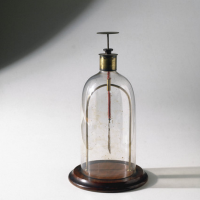Jean Antoine Nollet (1700–1770) was a clergyman and physicist. In 1748, Nollet invented one of the first electrometers, the electroscope, which detected the presence of electric charge by using electrostatic attraction and repulsion. Nollet later wrote a theory on electrical attraction and repulsion based on the existence of a continuous flow of electrical matter between charged bodies and became the the first professor of experimental physics at the University of Paris.
""Osmotic pressure, the pressure that develops in a solution separated from a solvent by a membrane permeable only to solvent, was first described by Abbé Jean Antoine Nollet, who became professor of experimental physics at the College of Navarre.
In 1746, the abbé Jean Antoine Nollet, a physicist who popularized science in France, discharged a Leyden jar in front of King Louis XV by sending current through a chain of 180 Royal Guards. In another demonstration, Nollet used wire made of iron to connect a row of Carthusian monks more than a kilometre long; when a Leyden jar was discharged, the white-robed monks reportedly leapt simultaneously into the air.""
According to Noah Dorsey:
""The simple electroscope consists of a metal case within which, and near its center, is supported in a vertical position a well-insulated metal strip to the top of which is attached a narrow strip of thin foil, preferably of gold leaf. This strip of foil is usually spoken of as the leaf. The strip of metal and the leaf constitute the insulated system of the electroscope. When the insulated system is electrically charged by a suitable switch passing through the wall of the case, the leaf is repelled by the strip, and is deflected from its normal, vertical position. In opposite sides of the case are windows through which the position of the leaf can be observed. Such observation is usually made by means of a microscope having in its eyepiece a ruled scale.""








